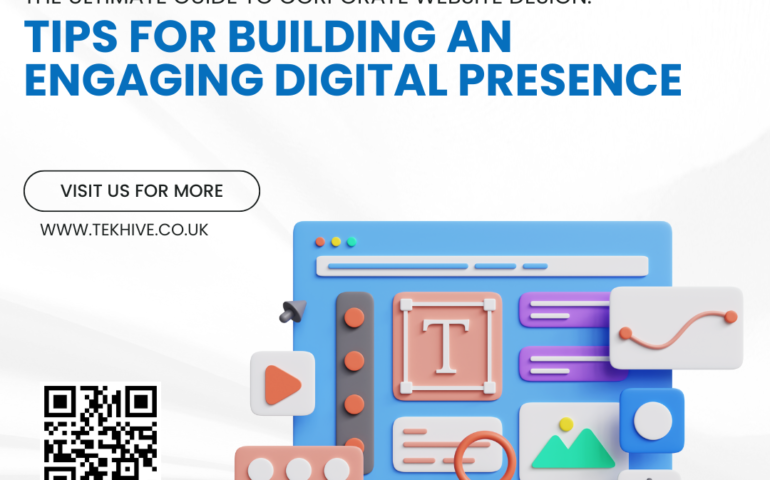
Corporate Website Design

Corporate website design plays a crucial role in shaping your company’s digital presence. It’s not just about aesthetics but also about functionality, user experience, and brand consistency. In today’s digital era, having a well-designed corporate website is essential for attracting clients, building credibility, and staying competitive. In this comprehensive guide, we’ll explore the key aspects of corporate website design, discuss best practices, and share tips for creating an engaging website. Let’s dive in!
1. Understanding Corporate Website Design
To begin with, corporate website design focuses on creating professional and visually appealing websites that reflect a company’s brand identity. Unlike personal or e-commerce websites, corporate sites aim to deliver information, communicate values, and engage with a broad range of stakeholders. Therefore, every element of the design, from layout to content, should align with the company’s mission and objectives.
Key Features of Corporate Website Design:
- User-Friendly Navigation: Ensures visitors can easily find information.
- Responsive Design: Adapts to all devices, from desktops to smartphones.
- Consistent Branding: Uses logos, colors, and typography that align with the brand.
- SEO Optimization: Includes keywords, meta tags, and optimized content.
- Secure Browsing: Employs SSL certificates and data protection measures.
2. Importance of Corporate Website Design
Moreover, a corporate website is often the first point of contact between a company and potential clients. Thus, the website needs to leave a lasting impression. Not only should it look professional, but it must also deliver a seamless user experience. Websites that are slow, confusing, or poorly designed can drive users away, affecting both brand reputation and conversion rates. For this reason, businesses must invest in a design that is both visually appealing and highly functional.
Why Invest in Professional Corporate Website Design?
- Builds Trust and Credibility: A clean and professional design communicates trust.
- Increases Engagement: Engaging design keeps users on the site longer, reducing bounce rates.
- Boosts Lead Generation: Clear calls to action (CTAs) and contact forms help generate leads.
- Improves SEO Performance: SEO-friendly design boosts search engine rankings, increasing visibility.
3. Best Practices for Corporate Website Design
Now that you understand the basics, let’s discuss some best practices that can enhance your corporate website design.
a) Prioritize User Experience (UX)
First and foremost, user experience is crucial. A well-designed corporate website should be easy to navigate, allowing users to find the information they need without hassle. It’s important to structure the website logically, using intuitive menus, clear headings, and easily accessible content. Additionally, incorporating features such as a search bar, sticky headers, and clear CTAs can further enhance UX.
b) Focus on Responsiveness
Secondly, a corporate website must be responsive. This means it should function optimally on desktops, tablets, and smartphones. Responsive design is no longer optional—it’s a necessity. Not only does it improve user experience, but it also impacts SEO rankings, as search engines prioritize mobile-friendly websites.
c) Implement Consistent Branding
Consistency in branding is essential for corporate website design. From the homepage to inner pages, the website should reflect the same color schemes, fonts, and brand messaging. This creates a cohesive look and reinforces brand identity. Moreover, consistent branding aids in brand recognition, making it easier for users to remember the company.
d) Optimize for Speed
In addition, website speed significantly affects user experience and search rankings. Studies show that users expect a website to load within three seconds; otherwise, they are likely to leave. Therefore, optimize images, use caching techniques, and limit the use of heavy scripts to ensure fast loading times.
e) Incorporate Strong CTAs
Furthermore, clear and compelling CTAs are vital for generating leads. These buttons or links guide users toward actions such as signing up for a newsletter, scheduling a consultation, or downloading a brochure. The CTAs should be placed strategically throughout the site to drive conversions.
4. Essential Elements of an Effective Corporate Website
While there are many elements to consider, here are the most crucial ones:
- Homepage: Acts as the face of your business. It should be clear, concise, and highlight the company’s value proposition.
- About Us Page: Provides detailed information about the company’s history, mission, and vision. This page builds trust and transparency.
- Service or Product Pages: Explains what the company offers, with details and benefits clearly outlined.
- Contact Page: Includes contact forms, phone numbers, email addresses, and physical addresses if applicable. It makes it easy for visitors to reach out.
- Blog Section: Offers valuable content that can drive traffic, improve SEO, and establish authority in the industry.
5. Tips for SEO Optimization in Corporate Website Design
To rank higher on search engines and attract more visitors, SEO must be integrated into the corporate website design.
a) Use Relevant Keywords
To start with, conduct keyword research to identify relevant terms related to your business. Incorporate these keywords naturally in headings, content, meta descriptions, and alt text for images.
b) Optimize Meta Tags
Equally important is the optimization of meta titles and descriptions. These elements help search engines understand the content and purpose of each page, improving visibility.
c) Utilize Internal and External Links
Both internal and external linking are beneficial for SEO. Internal links improve site structure and user navigation, while external links enhance credibility by linking to authoritative sources.
d) Incorporate Structured Data
Structured data helps search engines understand the content better, potentially earning rich snippets in search results. This can boost click-through rates and improve site rankings.

Final Thoughts on Corporate Website Design
In summary, corporate website design is a strategic investment that goes beyond aesthetics. It combines user experience, branding, and SEO to create a digital presence that reflects a company’s values and goals. By following the best practices mentioned above, businesses can build engaging websites that not only attract but also retain clients. As a result, they can improve their online visibility, drive conversions, and achieve long-term growth.
If you want to read more information about how to boost your website traffic, just visit –> TekHive





